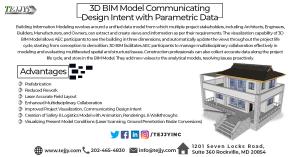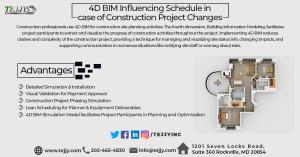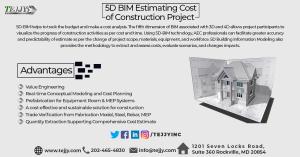[ad_1]
BIM dimensions 2D – 8D enhance model data for better understanding of building project, visualizing project delivery, cost and building facility maintenance.
— Sukh Singh
WASHINGTON DC, DISTRICT OF COLUMBIA , USA, December 20, 2021 /EINPresswire.com/ — BIM is revolutionizing the construction sector. As a real-life model, the technique facilitates AEC professionals to identify potential problems at the pre-construction stage. The collaborative process is empowered by the creation and exchange of applicable digital information throughout the building asset.
BIM Market Projection:
As per the research conducted by Markets & Markets, the BIM market is anticipated to grow from USD 4.5 billion in 2020 to USD 8.8 billion in 2025 at a CAGR of 14.5%.
Some of the factors impacting the growth of the Building Information Modeling Market include:
• Increased urbanization & population growth
• Rise of infrastructural projects
• Enhanced government mandates necessary for BIM implementation
Pre-Covid Situation for the BIM Market:
• Building Information Modeling provided the benefits of 3D visualization, collaboration, management of design-build process, construction planning, clash detection and construction cost reduction.
• Hence, the BIM market was projected to reach 9.5 billion in 2025 at a CAGR of 12.7% from 2020 to 2025 during the Pre-Covid situation.
Post-Covid Scenario for the BIM Market:
• The covid-19 pandemic is expected to bring an overall negative impact to the BIM market.
• As per Associated General Contractors of America, 45% of contractors undertake delays & disruption due to the outbreak of the disease.
• Bottlenecks are caused due to the scarcity of material supplies, quantities & building equipment.
• The dearth of labor & construction safety equipment, upsetting the global construction sector.
• Stoppage or delay of building projects due to temporary shutdown, when employees tested COVID-19 positive.
• The market is estimated to reach 8.8 billion by 2025 at a CAGR of 14.5% from 2020 to 2025 (which is a sharp .07% decrease, compared to the Pre-Covid forecast).
What UNO has to say?
• As per United Nations, the world’s inhabitants would increase to 8.1 billion in 2025 and reach around 10 billion by 2050.
Inference from UN statement in favor of BIM:
• To address a huge population, the AEC industry would deliver smart solutions in BIM urban engineering to develop the future infrastructure.
• Growth of the population and markets accelerated the prerequisites for housing and infrastructure to fuel the advancement of the global construction industry.
• Increased construction would lead to greater requirements for competent techniques of operation.
• BIM Services would provide AEC professionals the proficiency to plan and design buildings and manage projects.
• Consequently, BIM modeling services are gaining popularity, producing a global framework for the AEC professionals to advance in the right direction with a rulebook to work with BIM technology.
International BIM Standards to reduce Construction Cost:
• Novel Standards like ISO 19650 in the BIM Market established as per British Standard BS 1192 & Public Standards PAS 1192 would reduce construction costs by 22%.
What is BIM?
Building Information Modeling is a digitized technique of creating and managing information on a construction project. The coordinated design-build process involves a combination of 3D models and connected data like product, execution and facility management handover information. The process and data of Building Information Modeling are internationally defined in the ISO 19650 as well as 12006 standards. Whenever specific information is provided in the model, a different dimension is set, leading to around 8 key dimensions like time, cost, sustainability and so on. In the architectural, engineering and construction (AEC) sector, BIM is increasingly used to reduce material wastage and assess virtual risks. BIM also helps to detect clashes and decrease errors on-site. To put it clearly, the technique supports the construction and the design process from conception to completion and beyond for all stakeholders involved in the project. Hence, there is no doubt about the fact that Building Information Modeling is revolutionizing the construction sector by providing information access and collaborating with project team members. So, every builder and designer must understand the BIM model and its various components.
What are BIM Dimensions?
Building Information Modeling doesn’t just mean the 3D model creation of a structure. This implies information associated with the phases of design, construction and maintenance. BIM dimensions 2D, 3D, 4D, 5D, 6D, 7D and even 8D enhance the model data for a better understanding of the building project. Additional information visualizes the process of project delivery, cost and building facility maintenance.
BIM Dimensions/Level of Information in BIM Data:
Types of Dimensions & Purpose:
3D Modeling– Geometrical/Graphical Information – Visualize Building in 3 Dimensions by Updating Views throughout project life-cycle from conception to completion
4D Scheduling/Simulation/Sequencing/Construction Phasing – Time-Related Information to model construction sequence & plan project
5D Cost Estimation/Analysis/Cost Management/Quantity Take-off/Bill of Materials – Tracking Budget & Making Cost Analysis
6D Sustainability/Energy Analysis – Accurate energy estimation in the design-build stage for high-performance facilities
7D Facility Management & Maintenance – Facility Operations & Maintenance throughout the building lifecycle
8D Site Accident Prevention – Design Optimization, providing the best result at the pre-construction stage
Significance of BIM Dimensions:
• Help to start client conversations, demonstrate several BIM use cases and develop accurate project requirements
• Provide an improved understanding of building projects & the process of linking additional data dimensions to building models
• Facilitate engineers to get a better building insight and virtually assess project risks through intelligent model-based technique
• Reduce wastage for building contractors
• Decrease inaccuracy in information exchange for architects
• Collect information like reality capture data and store it in a user-friendly location
• Give real-time and centralized information to project stakeholders
• Enable collaboration amongst suppliers, building owners & other AEC professionals
Explore the different BIM dimensions in detail from 3D to 8D.
3D BIM: Shared & Coordinated Information Model
3D digital geometric model is the most popular BIM dimension having X-axis, Y-axis and Z-axis of a building. BIM 3D Modeling helps to generate schedules and report on different types of objects within the 3D model. Usually, multiple 3D models are combined to find out geometric clashes to enhance project efficiency and reduce the risk of project errors. Specification information gets linked to the objects for providing a richer set of coordinated information. If information gets stored in a cloud tool, detailed decisions could be made in a database, coordinating complex information in the 3D model.
Purpose: Model sharing in a common data environment (CDE) for effective design, construction and maintenance of the building project
Uses:
• Creation of schematic design, design development support, construction documentation, and record drawings
• Geographical data extracted from the model facilitate stakeholders to visualize building at the pre-construction stage
• Stakeholders examine and address structural issues before proceeding to the next level
Benefits of 3D BIM dimension:
• Improved 3D Visualization
• Clash Detection at pre-construction
• Enhanced communication amongst team members
• Ensure project transparency
• Detailed model creation to share realistic design expectations amongst stakeholders
• Reduced rework and design revisions through effective communication
• Multidisciplinary collaboration, reducing rework
4D BIM: Scheduling Information to Construction Sequence
Adding a time dimension to the 3D model enables project team members to visualize how the construction is sequenced. However, considering the point of the contractors, this is very significant. 4D BIM is a great step ahead that demonstrates collaboration between the design and construction team through model sharing. 4D BIM model reveals additional dimensions, like time element and scheduling data. The technique provides additional information about a building project in the form of scheduling data. As the project progresses, this data gets added to the components being built.
Purpose: 4D provides an extra dimension to a project, describing task duration & time for building development with regards to the construction phases.
Uses:
• Saving data loss, enhancing communication between work management and suppliers
• Accurate material placement on the construction site
• Re-organizing project timing as per dynamic and analytical evaluations
• Enabling site manager to divide workflow into periods, connected to elementary model parts
• The logical progression of simulated building phases for project control & management
Benefits of 4D BIM dimension:
• Proper planning of building site, including the schedule of construction stages
• Enhance the quality of the construction site planning
• Foster a good work relationship & cooperation amongst AEC stakeholders with a clear deadline
• Mitigate disputes and delays
• Clash detection at pre-construction through on-site verification & well-managed information
• Change visualization throughout the entire project life-cycle
• Improved schedule optimization and construction site planning
• Increased building safety through comprehensive construction plans
5D BIM – Best Fit for Design-Build Project & Cost Analysis
5D BIM adds cost information to a model, which is 4D BIM + cost. The technique of 5D BIM modeling integrates cost, schedule, and design. The 3D model predicts the flow of finance and visualizes the construction progress, resulting in project accuracy. Through a 5D approach, the cost reports can be modified at any time from unforeseen circumstances like design changes or other modifications. Using 5D BIM, all AEC stakeholders calculate project design costs and conceptualize and evaluate costs beforehand, enabling informed decision making.
Purpose:
Eliminates the need to calculate estimates manually and boosts project productivity from the early stage of design to final construction.
Uses:
• Measurement extraction to define material/quantity necessary for modeling elements
• Monitoring choices by the quantity surveyor & verifying with the designers
• Reducing chances of data loss, streamlining information management, linking dimensions to building life cycle
Benefits of 5D BIM Dimension:
• Obtain exact budget estimate with a detailed breakdown, understanding project details
• Clear information about schedules, costs & project scope, eliminating misunderstanding
• Cost visualization, bringing shorter project cycles
• Project cost modification, understanding project scope
• Real-time notifications and visualization of the cost overrun
• Automated count for equipment, components & building systems related to a project
6D BIM – Sustainability, Energy Efficiency & Facility Management
6D BIM includes the addition of relevant information, supporting the building’s facility management and operation and bringing about an improved business outcome. The technique of 6D BIM involves a model created by a designer that gets updated throughout the construction workflow. This model gets submitted to the building owner as an “as-built” model, comprising the information needed for future maintenance like for instance warranty, manual, operation, and maintenance.
Purpose: 6D BIM supports sustainability & energy efficiency of the building structure, analyzing energy usage during the initial design-built process.
Uses:
• Provides detailed building information to enhance project facility management & operations
• Involves information about installation, maintenance & configuration details for energy analysis, and decommissioning
• Simulates practically, enabling an exhaustive analysis & sustainability
• Ensures reduced energy consumption & improved quality, guaranteeing the sustainability of the construction project
Benefits of 6D BIM Dimension:
• Making fast and easy decision making
• Detailed analysis of the project operational phase
• Planning a building maintenance phase.
• Reduced energy consumptions
7D BIM – Blend of 3D, Time Schedule, Cost & Sustainability
Project managers use 7D BIM during the maintenance and project operational stage throughout the entire project life cycle. 7D BIM optimizes the project management work from conception to demolition. Asset data tracked through 7D BIM Dimension include warranty & technical details, operational manual and other asset data.
Purpose: Improves facility management and operation, enabling AEC stakeholders to track essential asset data like building status, technical specifications, warranty, and operations.
Uses:
• Tracks significant asset data like status, maintenance and operations of building facility
• Collates all facility management information at a single place within the BIM models
• Improves service quality throughout the project life-cycle
Benefits of 7D BIM dimension:
• Monitors facility management & assets from the design-build stage to completion & beyond.
• Changes building parts and repair of a building/project throughout the project life-cycle
• Facilitates maintenance for the contractors & subcontractors
• Optimizes asset maintenance and management
8D BIM – Accident Prevention Tool
8D BIM adds to the health and safety of the building information set, managing the connection between design and construction site safety. The technique is an effective method of preventing hazards in the construction sector. Using this modeling tool, construction professionals detect risks at the pre-construction or the design-build stage.
Purpose: Eliminates hazards at the source through prevention of design errors
Uses:
• Simulates & optimizes building designs about stakeholders’ concerns, feasibility & value
• Sustainability analysis, operational efficiency & facilities management
Benefits of 8D BIM Dimensions:
• Outline hazard for creation of BIM modeling components
• Safe planning for design
• On-site risk control for hazards through design review
Final thoughts
Using BIM dimensions, AEC professionals define information requirements for the building project deliverables. BIM 3D – 8D Dimensions help to examine the project requirements, comprehend the information requirement and the person accountable for developing it. If you want to completely understand a building project from the initial design to construction, you should be acquainted with the BIM dimensions – 3D, 4D, 5D, 6D, 7D & 8D. This is because these dimensions facilitate enhancing the data of a construction model.
Sukh Singh, the Vice President of Tejjy Inc. states – “BIM streamlines the entire construction project lifecycle and makes it easier for AEC professionals to communicate, regardless of whether they are on-site or office. Our BIM engineers use the BIM Dimensions carefully in project workflow and open the door to endless possibilities for building design and construction.”
Are you searching for the best BIM service provider? Tejjy Inc. is one of the competent BIM service providers in USA, collaborating with clients to meet their construction requirements. Tejjy’s BIM services encompass 3D Modeling, 4D Scheduling, BIM Clash Coordination, Shop Drawings, 5D Quantity Take-off, 6D Energy Efficiency, 7D Facilities Management and 8D BIM Accident Prevention for AEC projects. Tejjy team of BIM modelers executes projects efficiently, understanding specific client needs.
Why Choose Tejjy Inc.?
• Better building design for better buildings
• Collaborative 3D modeling of building structures
• Efficient project coordination through laser scanning
• 360 degree visualization of building structure with 3D walkthrough & rendering
• Improved construction planning with 4D BIM
• Fast clash detection & resolution
• Comprehensive shop drawing creation
• Accurate project cost estimation with 5D BIM quantity take-off
• Construction phase support through BIM
• Enhanced facility management with 6D/7D BIM
Success Stories of Tejjy Inc. BIM Modeling Service Provider:
• Laser Scanning for a Building Information Modeling Project in Baltimore
• Crafted Structural Marvel for Signal House Project
• Architectural Modeling for a Religious Building
• Building Information Modeling Came Handy for Northeast Water Purification Plant Expansion in Houston
• Clash Detection & Coordination for DC Courthouse
• Intelligent Revit Modeling for Medical Facilities Support Services
Drop a mail at info@tejjy.com or call Tejjy directly at 202-465-4830 to discuss your construction project.
sukhchain singh
Tejjy Inc.
+1 240-595-4210
email us here
Visit us on social media:
Facebook
Twitter
LinkedIn
Other
What is Building Information Modeling(BIM)? | BIM Service providers in DC | Tejjy Inc.
![]()
[ad_2]
Source link





